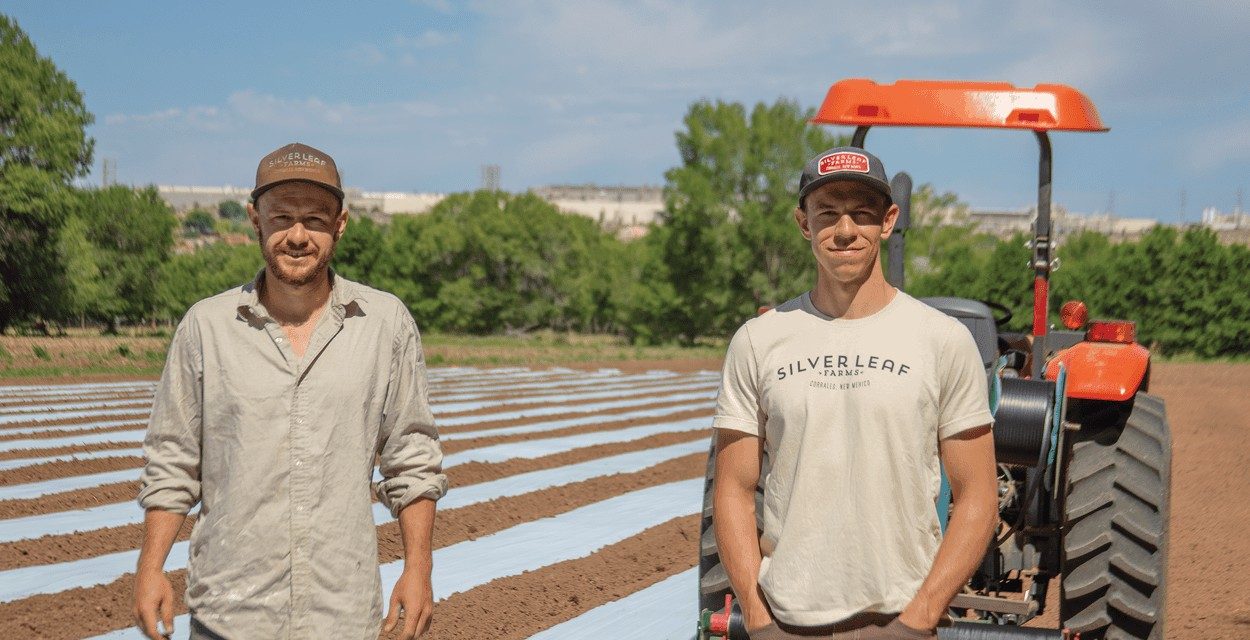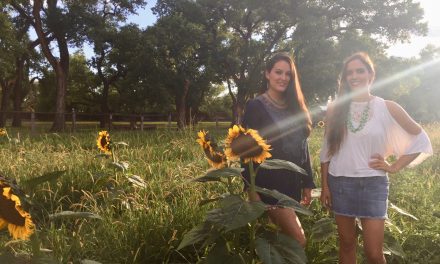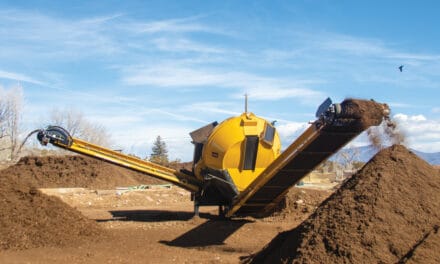Corrales Voters Pass Bond to Support Farmland Preservation
By Lisa Brown · Photos by Stephanie Cameron

Aaron and Elan Silverblatt-Buser of Silver Leaf Farms prepping conservation easement for first planting.
Voters in the Village of Corrales spoke with an unqualified voice earlier this year when they overwhelmingly supported a ballot measure to preserve farmland in their village. The measure allows for $2.5 million in general obligation bonds to procure easements for agricultural and wildlife conservation use. Though residential development has taken place here at breakneck speed, we’ve always grown our own food in this part of the Rio Grande Valley—from pre-contact Pueblos to our recent ancestors to our new farmers. This measure helps meet one of our small farmers’ greatest challenges: access to land. Its passage demonstrates how a small community can support the local food movement.
Although open spaces in the village are now interspersed with custom homes, Corrales is uniquely situated to preserve its remaining open fields. Newcomers recognize that they benefit from the farms next door, which increase property values and provide a community environment illuminated by open space, so they’ve bought into farmland preservation and protecting a way of life. Passage of the farmland preservation bond continues a program begun in 2004, which was used to permanently preserve almost forty acres of farmland in Corrales. The funds from the first bond were exhausted last year, leading to the measure for a new bond. Since developers covet prime agricultural land, farmers are often priced out of the market. By preserving some of Corrales’ remaining farmland and making it available to local farmers, the village is helping to secure its own local food supply.
Older Corraleños still recall that it was local farms which kept the community from going hungry during the Great Depression. However, by the late twentieth century, Corrales’ agricultural heritage was losing ground. Bonnie Gonzales and her husband Al bought land in Corrales in 1988, built their adobe house by hand, and moved in in 1990. They’d found a place where they could grow food for their new family. But, she recalls, “It didn’t take long for concern to set in—concern I saw reflected in the eyes of people of this village who’d been here much longer than I had. The farm stands were declining amid the growing housing industry, and there was spotty support for a centralized marketing facility.”

Top: Field Manager Anita Adalja and Conor Gilliland stringing cucumber vines. Bottom: Butter lettuce and tomatoes in production.
Corrales’ matriarch farmer, the late Evelyn Losack, conceived of the first Corrales farmers market around 1986. With the proliferation of chain grocery stores, delivery trucks stopped coming to Corrales to buy the produce to take to Albuquerque in the seventies, and Losack was tired of driving into town to sell her apples and chile. Local grower Russell Trujillo was among the first to sell his onions in front of the Mercado de Maya, across from the elementary school. Russell was later instrumental to the formation of the current growers market, connecting the Gonzaleses to New Mexico Department of Agriculture grant programs and the state farmers market association to develop marketing resources.
By the late nineties, the couple had quit their corporate jobs and moved full-time into agriculture. Their biggest concern was marketing, and so they worked to get the definition of a growers market into the village land-use code, thus creating a self-supporting and reliable location and structure. The Corrales Growers’ Market has expanded continuously since that time, adding new growers every week. One factor that makes this possible is Corrales’ farmland preservation program, rooted in the creation of conservation easements. “Because farmland easements create a usable (more than one acre) block of land, they can support larger farming operations, and we gain all the benefits: local food production, open space, habitat, view sheds, and a community environment that showcases the land to draw target customers to Corrales,” says Gonzales. “They come to the market for the freshest food, the healthiest food, and the most delicious food because that is the food they want to feed the people they love,” she says.

Conservation easement in production in Corrales.
The Corrales Farmland Preservation and Agricultural Commission began as a committee formed primarily to assist the village’s administration with the process of creating conservation easements on farmland. In 2004, the village received a $1.5 million grant from the USDA’s Natural Resources Conservation Service and passed the initial general obligation bonds in matching funds to purchase development rights from landowners who wished to preserve their land. The land remains theirs, though the easement is held in perpetuity by a land trust that works with the village. The land may be sold, but the easement passes to the next owner.
The Juan Gonzales Bas Heritage Farm, five and a half acres in the heart of Corrales, earned a conservation easement purchased during the first round of bond sales in 2004. It is the only preserved property that is owned by the Village of Corrales so far. The village aspires to create a flagship farm there, using sustainable agricultural practices and providing educational opportunities for the community through a public-private partnership. The Commission’s duties expanded to include management recommendations for the village-owned farm, as well as to encourage and sustain local farmers generally, by promoting access to a local market and, as its mission statement says, supporting “traditional agricultural economic development.”
Aaron and Elan Silverblatt-Buser grew up in Corrales. They now own Silver Leaf Farms, a USDA certified organic vegetable farm that pays its expanding number of employees a livable wage. They are first generation farmers, part of the movement to maintain our core values. They currently farm two parcels of land preserved by Corrales’ farmland preservation program, comprising around six acres, and have the potential to do more. “Access to farmland in semi-urban or peri-urban centers is one of the largest problems facing young and beginning farmers. No exception here. There are lots of half-acre and one-acre plots of land left in Corrales; however, in order to appropriately scale our operation, we need to have access to contiguous land. We always thought we would have to move out of Corrales to find larger plots of land,” says Elan.
Conservation easements are an effective tool for landowners to keep their properties in permanent conservation while providing access to land for local farmers. “In places like Corrales, the idea of a farmer purchasing land is laughable because of the intense pressure to develop,” says Elan. “Land in conservation is in conservation forever. This means that we are only stewards in the longer trajectory of the land. Being on land that has a conservation easement allows us to think about the longer-term health of the soil and the surrounding ecosystem.”
That ecosystem is fragile. Climate change is shifting the way water flows. Moving agriculture forward here will require close observation, attention to consequences, and adjusting how crops are grown to find the right balance. But preserving farmland is the necessary first step to sustaining our farmers and creating new ones.
www.corralesgrowersmarket.com; www.eatsilverleaf.com;
corrales.nm.org/committees-and-commissions
Edible celebrates New Mexico's food culture, season by season. We believe that knowing where our food comes from is a powerful thing. With our high-quality, aesthetically pleasing and informative publication, we inspire readers to support and celebrate the growers, producers, chefs, beverage and food artisans, and other food professionals in our community.












